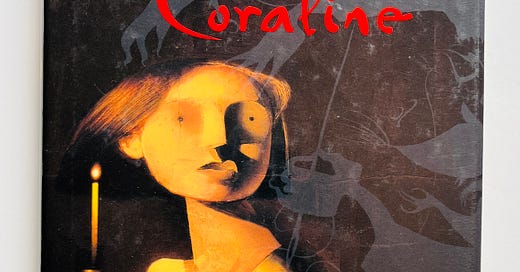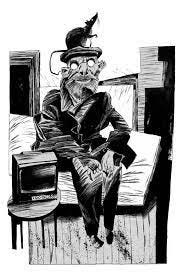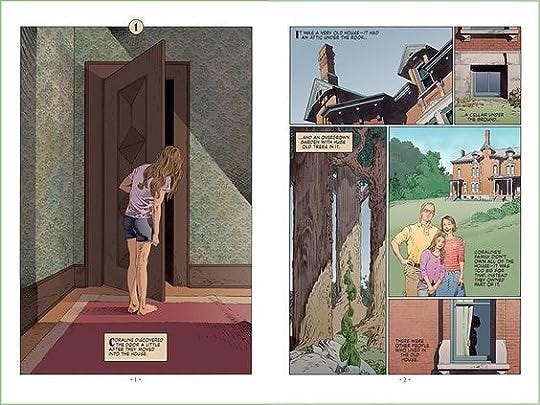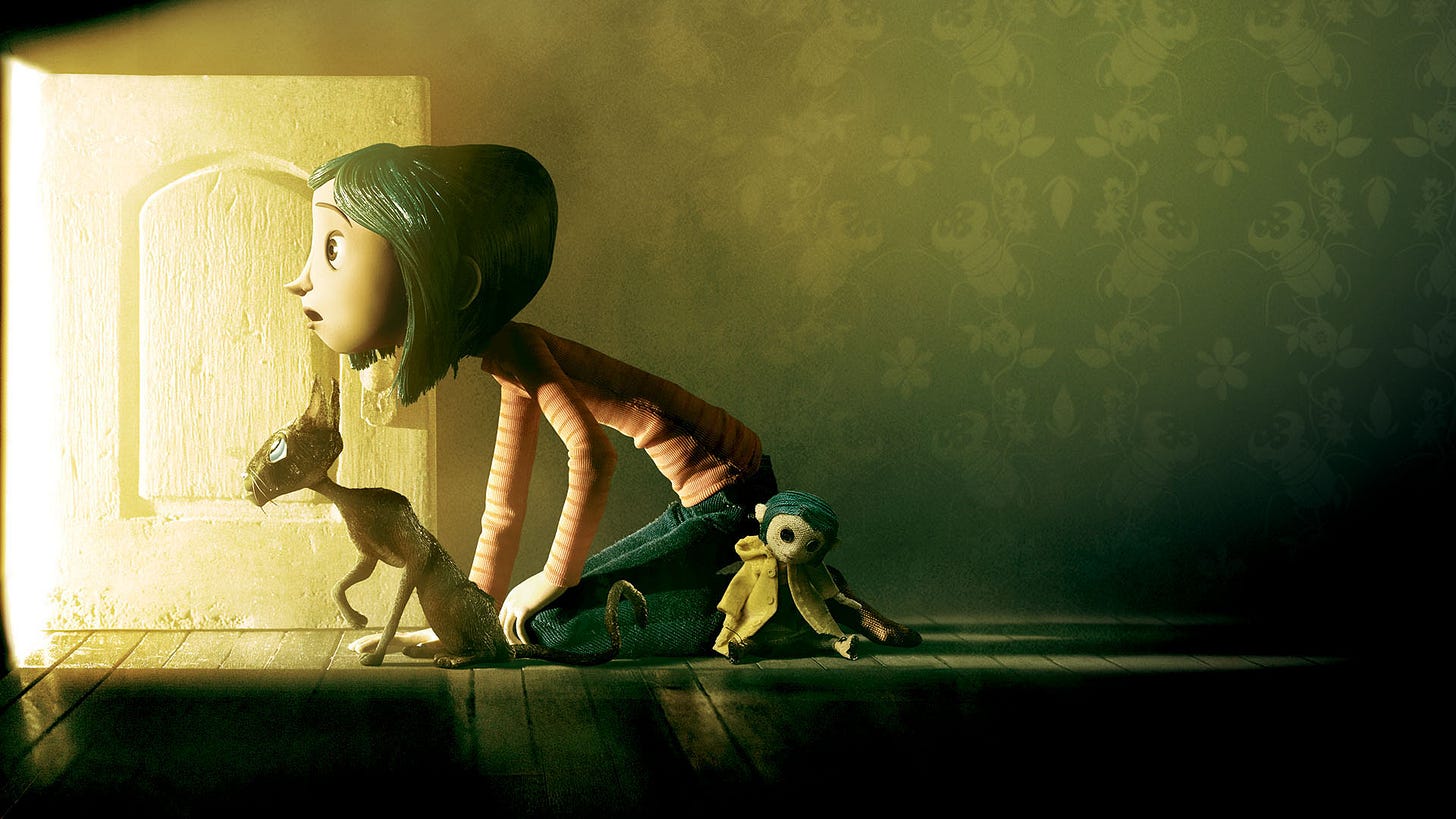#130: Coraline by Neil Gaiman
A collaboration with Sarah Miller from "Can we read?"
Happy Friday!
It’s a BSR double feature! Here is the second collaboration of the week. Sarah was so fun to work with and her Substack community is a peaceful, happy place on the internet. If you live with, work with, or simply want to inspire young readers, consider subscribing!
Her part that covers the book is first followed by my bit about the movie. Enjoy!
Coraline by Neil Gaiman (2002)
When Coraline was published in 2002, I went out and bought it and read it promptly.
It’s a middle-grade novel and I was 20 years old, so that piece of information may sound a little surprising, but I was in a really bad place in my life — I’d opted to drop out of college after the first semester of my freshman year because I was pretty sure if I stayed in Minneapolis, all alone, I was going to kill myself, and my parents listened to me when I told them I needed to come home. I got a job working as a server and hostess at an Italian restaurant, which provided me with a pile of cash, the opportunity to make many bad choices (I took every one), and a lot of room to focus on staying alive.
As such, I was back living in my childhood bedroom, surrounded by my childhood things — including my big IKEA bookcase, the largest of the Kallax line, which remains truly one of the best things my parents have ever bought for me. I had all my old picture books, even some of my board books, on some of those shelves (I repeat: I was 20), and there was nothing and no one stopping me from pretending I was eight years old from the time I woke up (usually around noon) until the time I had to be at work (4pm).
So I bought and read Coraline because, I suppose, I was trying to soothe myself in the best and most reliable way I knew (know) how: reading books.
I loved it — and I was disturbed by it — so when Kyle and I landed on it as the book we wanted to cover together, I was excited to revisit it (especially after having finally made peace with that time in my life, and finding deep compassion for the lost young adult I once was).
I decided, this time, to listen to it on audiobook with my children, who are 9 and 7yo (as of tomorrow, my youngest’s birthday). Of course a huge part of the appeal of this format is Neil Gaiman, who narrates his own books. I mean have you listened to Neil Gaiman narrate his own books? He’s so good — so monstrously skilled at this — that part of me wishes he’d narrate every book ever, but perhaps this is only because the magic he brings to reading his own books is so potent and powerful (and it would surely be diminished if it were overused).
In any case, the story is this: Coraline is a little girl living with her parents in an unnamed time period, in a large, rambling old house that has been divided into three flats. Her neighbors above and below are an eccentric crew, and her parents, though loving, are pretty hands-off. She spends a great deal of time alone.
One day, she discovers a never-before-seen door in the unused parlor of her apartment. Her mother opens it with the oldest, darkest key on their family key ring to reveal a brick wall. But a few days later, Coraline uses the key to open the door again and this time, steps into another version of her house, complete with the people and animals and the world she is used to, only with a few relevant — and super creepy — differences: it’s cool that the cat in this other world can talk to her, but far less cool that her “other mother” and “other father” have big shiny black buttons where their eyes should be. And ask her to stay in this “other house” permanently.
Coraline knows something is deeply wrong with this scenario, and her gut instinct is confirmed when she goes back to the normal side of her house to find her parents have disappeared. It takes her two days to discover they’re trapped behind a mirror that seems to reach both sides of this perplexing residence — and along with them, she finds other children, children lost long ago, held captive by this “other mother.”
As you can imagine, things only get worse from there.
Though I’d love to unpack every element of this delightfully frightening story — what’s scarier (and more metaphorically rich) than the people you love revealing another version of themselves? Hasn’t this, in some ways, happened to all of us, in one form or another, especially by the time we’re reading this aloud to our children? — but I don’t want to give away too much of the narrative or the ending so that you can read this one for yourself. It’s too good.
There is absolutely zero mention of Halloween in this book — and it’s not outright alarming (neither of my kiddos can handle stories like that), it’s more… sinister and unnerving and spooky, and that’s certainly relevant this time of year. (And, I swear I am telling the truth when I say that I got legit, bottom-of-the-spine up to my hairline chills listening to this story — twice! — while driving with my small fellow listeners.)
I am 100 times more unsettled by this excellent creepshow of story than I was 21 years ago, and I highly recommend getting your hands (or ears) on it.
(Is “creepshow” a word? It is not. But Coraline is a creepshow, so there you go.)
(Here’s my part)
Hello Can we read? readers! It’s a pleasure to collaborate with Sarah on a story that has tunneled its way into my brain over the past few weeks. I read Coraline for the first time for this project and it delivered a creepy and spine-tingly story that I also found sweet and thoughtful. I don’t consider it a children’s book, but the story of how it became a children’s book is a good one!1
After I finished, I checked out the graphic novel and listened to the Gaiman-narrated audiobook. Each reading in each format yielded something new and exciting.
The Harper Perennial edition of the book had unsettling illustrations by Dave McKean.
The graphic novel was adapted and illustrated by P. Craig Russell and was effective in translating Gaiman’s rich (but not overly detailed) descriptions into horrifying illustrations.
Gaiman’s audiobook narration is flawless and has some creepy touches that you’ll need to hear for yourself.
I had high expectations as I approached the film and a mental checklist of specific scenes and lines that I was hoping would make the cut.
Released in 2009, Coraline was written and directed by the legendary Henry Selick (James and the Giant Peach, The Nightmare Before Christmas) and was the first feature film made by the talented team at Laika Studios.2 Do yourself a favor and check out these behind-the-scenes videos of how Coraline was made because you have to see it to believe it. The team at Laika is painstakingly patient and dedicated to the art of stop-motion filmmaking.
The movie was recently remastered and briefly re-released in theaters at the end of August, so I got to see it on the big screen. It looked great. The stop motion style is well suited to the story of creepy button-eyed characters whose appearances aren’t what they seem. This film succeeds as an artistic triumph and was well deserving of the Academy Award nomination for Best Animated Feature.3
Aesthetically speaking, there are some design choices that may not be for everyone. There were a few characters that were downright off-putting. I don’t say that to discourage anyone from watching it, but to manage expectations. This isn’t squeaky clean Pixar animation or soft-edged Wallace and Gromit claymation. There are scenes near the end that young kids might find terrifying, so knowing what your kids can handle and previewing the movie yourself are the best approach.
On the story side, it was missing some of my favorite parts! What I consider the grand idea of the story was not included, which must have been intentional rather than an oversight. There was a part in the book where I nearly wept due to the power of the message, and it wasn’t included either.
Coraline is a phenomenal Dorothy-like protagonist who comes out on the other side of her adventure a different person. Her circumstances remain the same, but she is, somewhat ironically, now seeing everything with new eyes.
I recommend reading the book out loud or listening to the audiobook first, then checking out the graphic novel or the film if your kids can’t get enough. Let me know if you do, I’d love to hear about your experience!
Thanks for reading,
Kyle
Fun anecdote from Neil Gaiman’s non-fiction collection A View from the Cheap Seat:
But Coraline was only published as a children's book because Morgan DeFiore lied.
Her mother, Merrilee Heifetz, has been my literary agent for the last twenty-five years, and is the person whose opinion in all matters of books and publishing I trust the most. I sent her Coraline, and her opinion was that it wasn't a children's book it was too scary for children.
"I will tell you what," I told her. "Why don't you read it to your girls? If they're scared by it, we'll send it to my adult editor." Her girls were Emily, aged eight, and Morgan, aged six.
She read it to them, and they loved it, and they wanted to know what happened next. When she got to the end she called me and said, "They weren't scared. I'm sending it to Harper Children’s.”
Some years later I was sitting next to Morgan Defiore, who was then about fifteen, at the off-Broadway opening night of a Coraline musical. I told my now-wife, Amanda, the story, and explained that it was because Morgan was not scared that Coraline was a children's book. And Morgan said, “I was terrified. But I wasn't going to let on that I was scared, because then I wouldn’t have found out how it ended."
Laika’s other films include ParaNorman (2012), Boxtrolls (2014), Kubo and the Two Strings (2016), and Missing Link (2019). Of these, I’ve only seen Kubo — a family favorite — and Missing Link.
Unfortunately for Laika, this was the same year Up was nominated for Best Animated Feature and nothing was beating Up.
In fact, Disney has proven to be formidable opponent for Laika at the Oscars. ParaNorman lost to Brave in 2013, Boxtrolls lost to Big Hero 6 in 2015, and Kubo lost to Zootopia in 2017. In what may be the biggest crime of all, Toy Story 4 won in 2020 beating Missing Link and I’m not saying Missing Link should have won, but Toy Story 4 shouldn’t have. Since the award’s inception in 2001, a stop motion animated film has taken home the trophy only twice: 2005’s Wallace & Gromit: The Curse of the Were-Rabbit and 2023’s Guillermo del Toro’s Pinnochio.








Hi Kyle and Sarah 🙋
First, allow me to explain my sudden appearance,lol
I'm new to the platform, signed up last week and started my publication right away. I searched for publications with my similar interests but I didn't find book review publications like yours. I'm so glad I finally found you, and to find you a fan of Coraline is a bonus❤️. This book is one of my favourites, it's always on my recommended reads list. I used to read it as a child to study English. It's fun and easy to read. My friends tho didn't like it and always called me weird for liking such a dark and twisted story😂.Now that I remember those good times I think I should reread it and listen to their nagging 😂.
Anyway, I've subscribed to your newsletter, hoping to find my other favourite writers in here. You're welcome to subscribe to my publication as well, if you like old Victorian stories. I tend to focus on forgotten names of books and authors.
🌹🌹🌹🌹
Kyle, I can count on one hand the times in my life when anyone has called me "fun," so thank you for that 😂 It WAS fun working with you. (And I can't think of a better compliment than "her Substack community is a peaceful, happy place on the internet." Wow. That means so much to me.)